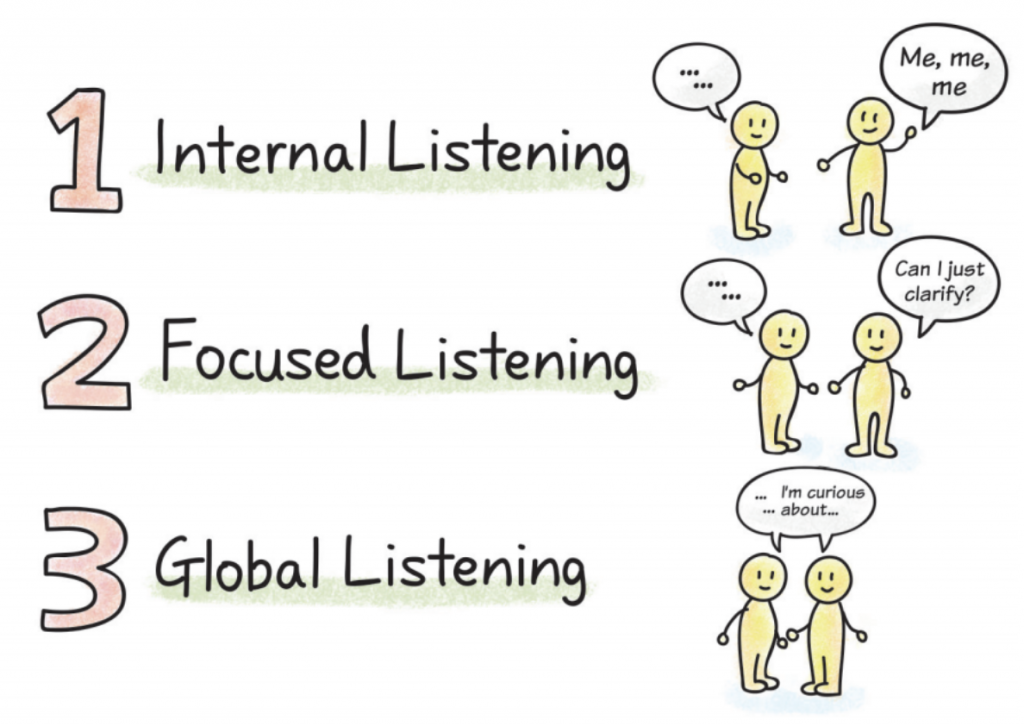As an agile coach I often write this blog about, well, agile topics. Today I want to focus on the other side of that title, and talk a bit about coaching: What it is, what it isn’t, and a couple of techniques a coach may use in their everyday work. This is not specific to Agile Coaching, but refers to coaching as a discipline. If you’ve ever heard of “coaching” and wondered what it is coaches do, read on.
If there was one thing that I could wish that everyone would know about coaching, it is this: Coaching, by definition, is not opinionated. What I mean by that is that a coach works with the experience, the knowledge, and the issues that the coachee brings to the table. Unlike a mentor or a teacher, they avoid giving their own advice or offering their own experience to the coachee, and because of that a coach does not even need to necessarily be a subject matter expert in the question being discussed – because their own knowledge is irrelevant anyway. (This is a problem with Agile Coaching, btw, since an Agile coach IS expected to be a mentor, a teacher, an agile expert, etc. But that’s a topic for a different blog post)
What a coach does instead of giving advice and trying to solve the coachee’s problem, is to try to lead the coachee to first identify the real issue that they are facing, and then to try to formulate a plan to address it. The coachee does the hard work, and the coach provides the structure and guides the conversation to where the coachee needs to go. It’s a tricky skill, and personally as someone who loves talking and giving advice, I found it challenging and humbling to learn. But it is immensely rewarding, and if you work with people I would highly highly recommend taking a coaching class.
So how does a coach guide the conversation? By listening and asking questions. Simple, right?
Yes and no. The idea behind not offering your own contribution is to be entirely focused on the person with whom you are talking. This is known as focused (or active) listening, and it’s defined as:
When the listener pays full attention to what is being said and trying to learn about the other person. Also in observing VIBE (Voice, Information, Body language, Emotions)
https://www.agile42.com/en/blog/2020/03/24/active-listening/

But of course, merely listening to a coachee, as focused as that listening is, will not help us move the conversation in the right direction. For this we have other coaching tools at our disposal, such as paraphrasing, reframing, G.R.O.W. model, and more. One of the most useful and versatile tools we have as coaches is the idea of powerful questions.
I was participating in a coaching circle recently organized Agile Coaching Circles that explained powerful questions in the following way:
- Powerful questions cannot be answered by Yes or No alone.
- Powerful questions invite deeper reflection.
- Powerful questions help the Coach to stay in curiosity
- powerful questions should be non-confrontational.
There are a lot of examples on the web for what powerful questions look like, so I’ll only give a couple of examples here. “What else?” and “what does success look like to you?” are great powerful questions because they encourage the coachee to look beyond the immediate issue or concern and focus on a bigger picture. “Why did you do that?” on the other hand, is not a good question, because it is confrontational and prompts the coachee to get defensive and look to the past rather than the future solution.
But my all time favorite powerful question has got to be “What’s the worst that could happen? And how likely is that?” It makes the coachee look past the unknown and amorphous cloud of scary uncertainty and pin down in concrete terms the risks of failure, which they often find are much smaller in reality than they have built up in their mind. It’s also a great self-coaching and self-motivation question to ask yourself when you need to make a decision. I’ve used it on myself several times in the last few months, trying to wrap my head around a scary (but potentially rewarding) course of action. I’ve found that simply asking myself this question, and writing down the answers, often makes the worst seem not so bad.
Powerful questions can focus the coachee’s attention on things that they have not previously thought of. They can expose hidden issues, unconscious attitudes, or even courses of action that were previously missed. They invite reflection and get the coachee talking.
And in that vein, there is one more powerful tool I’d like to mention: Silence. People are social beings. We’re conditioned to converse and to fill the silence. Sometimes it is better to lean back and say nothing for a moment or two, inviting the other person to talk more, rather than to jump in with the next question or point. You may be amazed at what you’ll hear when you are silent. (Sorry, couldn’t resist. But hey, at least I didn’t stick in a Simon and Garfunkel reference.)
Want to talk more about the Coaching, Powerful Questions, or anything else in the agile sphere? Drop me a line at boaz@makecodebetter.com or through my linkedin page!
